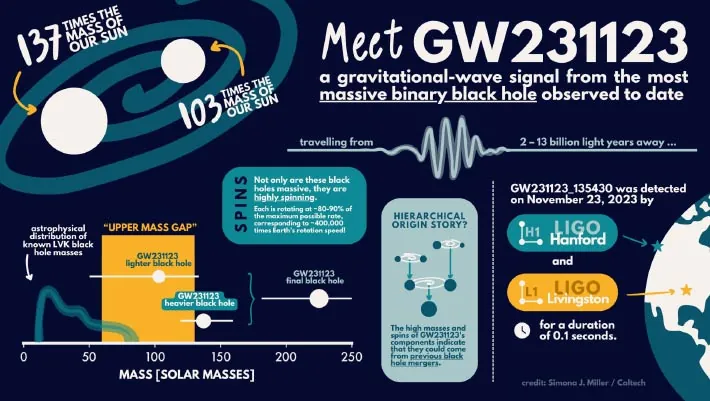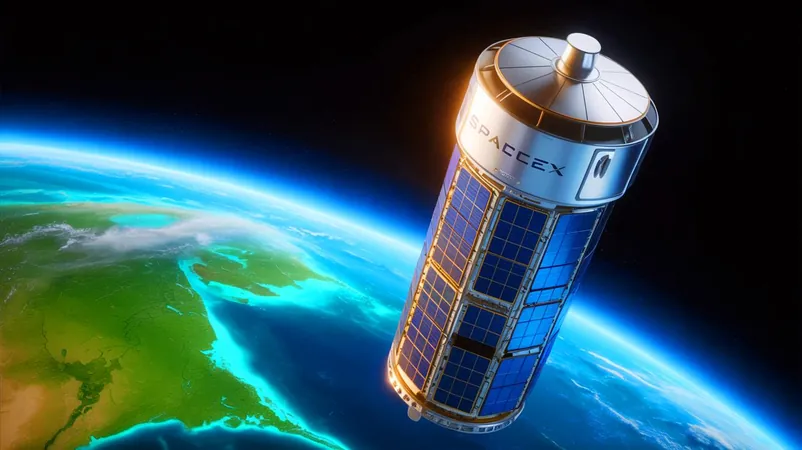
Cosmic Breakthrough: Gravitational Waves Reveal Record-Breaking Black Hole Merger
2025-07-15
Author: Olivia
A Historic Discovery in the Depths of Space
In a groundbreaking revelation, astrophysicists from the LIGO-Virgo-KAGRA (LVK) Collaboration have unearthed the merger of two astronomical giants: black holes boasting the highest combined mass ever detected. This astonishing event, cataloged as GW231123, was captured on November 23, 2023, resulting in a final black hole that weighs more than 225 times that of our Sun.
A Journey from the First Detection to Record Smashers
The Laser Interferometer Gravitational-Wave Observatory (LIGO) made waves—literally—in 2015 when it recorded the first-ever gravitational waves from a black hole merger. That event produced a black hole 62 times heavier than our Sun. Fast forward to now, and the LIGO detectors in Louisiana and Washington have joined forces with Italy’s Virgo detector and Japan’s KAGRA, allowing them to uncover more than 200 black hole mergers in their fourth observational run alone, summing up to around 300 since their inception.
Unveiling the Mystery of Massive Mergers
Prior to this, the heaviest merger recorded was GW190521 in 2021, which resulted in a black hole with a mass 140 times that of our Sun. However, GW231123 has shattered those expectations, with its constituent black holes merging to create a massive entity weighing in at an astonishing 225 solar masses.
The Enigma of Black Hole Formation
What’s even more intriguing is that this recent merger belongs to a rare class of intermediate-mass black holes—those that bridge the gap between stellar collapse and the supermassive black holes that dominate galactic centers. Remarkably, both merging black holes were also spinning at incredible speeds.
Dr. Mark Hannam, an astute astrophysicist at Cardiff University, states, "This is the most massive black hole binary we have observed through gravitational waves, presenting significant challenges to our understanding of how such mass concentrations can arise in the universe. These colossal black holes defy conventional stellar evolution models. One theory is that they may be the result of previous mergers of smaller black holes.”
Shining a Light on Black Holes’ Exotic Nature
Dr. Dave Reitze, the executive director of LIGO at Caltech, affirms the significance of this discovery: "This observation not only pushes the boundaries of astrophysical knowledge but also emphasizes how gravitational waves uniquely illuminate the complex and exotic nature of black holes across the cosmos."
Sharing the Excitement with the World
The details of GW231123 will be unveiled at the 24th International Conference on General Relativity and Gravitation (GR24) and the 16th Edoardo Amaldi Conference on Gravitational Waves, taking place in Glasgow, Scotland—an apt setting for such an extraordinary revelation.









 Brasil (PT)
Brasil (PT)
 Canada (EN)
Canada (EN)
 Chile (ES)
Chile (ES)
 Česko (CS)
Česko (CS)
 대한민국 (KO)
대한민국 (KO)
 España (ES)
España (ES)
 France (FR)
France (FR)
 Hong Kong (EN)
Hong Kong (EN)
 Italia (IT)
Italia (IT)
 日本 (JA)
日本 (JA)
 Magyarország (HU)
Magyarország (HU)
 Norge (NO)
Norge (NO)
 Polska (PL)
Polska (PL)
 Schweiz (DE)
Schweiz (DE)
 Singapore (EN)
Singapore (EN)
 Sverige (SV)
Sverige (SV)
 Suomi (FI)
Suomi (FI)
 Türkiye (TR)
Türkiye (TR)
 الإمارات العربية المتحدة (AR)
الإمارات العربية المتحدة (AR)